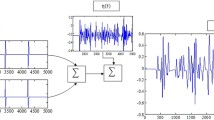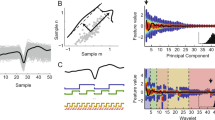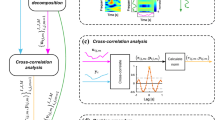Abstract
We describe in this paper advanced protocols for the discrimination and classification of neuronal spike waveforms within multichannel electrophysiological recordings. The programs are capable of detecting and classifying the spikes from multiple, simultaneously active neurons, even in situations where there is a high degree of spike waveform superposition on the recording channels. Sparse Decomposition (SD) approach was used to define the linearly independent signals underlying sensory information in cortical spike firing patterns. We have investigated motor cortex responses recorded during movement in freely moving rats to provide evidence for the relationship between these patterns and special behavioral task. Ensembles of neurons were simultaneously recorded in this during long periods of spontaneous behaviour. Waveforms provided from the neural activity were then processed and classified. Typically, most information correlated across neurons in the ensemble were concentrated in a small number of signals. This showed that these encoding vectors functioned as a feature detector capable of selectively predicting significant sensory or behavioural events. Thus it encoded global magnitude of ensemble activity, caused either by combined sensory inputs or intrinsic network activity.
SD on an overcomplete dictionary has recently attracted a lot of attention in the literature, because of its potential application in many different areas including Compressive Sensing (CS). SD approach is compared to the generative approach derived from the likelihood-based framework, in which each class is modeled by a known or unknown density function. The classification of electroencephalographic (EEG) waveforms present 2 main statistical issues: high dimensional data and signal representation.
Access this chapter
Tax calculation will be finalised at checkout
Purchases are for personal use only
Preview
Unable to display preview. Download preview PDF.
Similar content being viewed by others
References
Amirikian, B., Georgopoulus, A.P.: Motor Cortex: Coding and Decoding of Directional Operations. In: The Handbook of Brain Theory and Neural Networks, pp. 690–695. MIT Press, Cambridge (2003)
Babaie-Zadeh, M., Vigneron, V., Jutten, V.: Sparse decomposition over non-full-rank dictionaries. In: Proceedings of ICASSP 2009, Taipei, TW (April 2009)
Bishop, C.: Pattern recognition and machine learning. Springer, New York (2006)
Bodreau, M., Smith, A.M.: Activity in rostal motor cortex in response to predicatel force-pulse pertubations in precision grip task. J. Neurophysiol. 86, 1079–1085 (2005)
Breiman, L., Friedman, J.H., Olshen, R.A., Stone, C.J.: Classification and regression trees. Wadsworth International Group, Belmont (1984)
Candès, E.J., Tao, T.: Decoding by linear programming. IEEE Transactions Information Theory 51(12), 4203–4215 (2005)
Dash, M., Liu, H.: Feature selection for classification. Intelligent Data Analysis 1, 131–156 (1997)
Donoho, D.L.: For most large underdetermined systems of linear equations the minimal l1-norm solution is also the sparsest solution. Technical report (2004)
Donoho, D.L.: Compressed sensing. IEEE Transactions on Information Theory 52(4), 1289–1306 (2006)
Donoho, D.L., Elad, M.: Maximal sparsity representation via ℓ1 minimization. The Proc. Nat. Aca. Sci. 100(5), 2197–2202 (2003)
Elad, M.: Why simple shrinkage is still relevant for redundant representations? IEEE Transactions on Image Processing 52(12), 5559–5569 (2006)
Figueiredo, M.A.T., Nowak, R.D.: An EM algorithm for wavelet-based image restoration. IEEE Transactions on Image Processing 12(8), 906–916 (2003)
Gorodnitsky, I.F., Rao, B.D.: Sparse signal reconstruction from limited data using FOCUSS, a re-weighted minimum norm algorithm. IEEE Transactions on Signal Processing 45(3), 600–616 (1997)
Gribonval, R., Lesage, S.: A survey of sparse component analysis for blind source separation: principles, perspectives, and new challenges. In: Proceedings of ESANN 2006, pp. 323–330 (April 2006)
Gribonval, R., Nielsen, M.: Sparse decompositions in unions of bases. IEEE Trans. Inform. Theory 49(12), 3320–3325 (2003)
Hastie, T., Tibshirani, R.: Discriminant analysis by gaussian mixtures. Technical report, AT & T Bell laboratories, Murray Hill, NJ (1994)
Krakei, S., Hoffman, D.S., Strick, P.L.: Muscle and movement representation in the primary motor cortex. Science 285, 2136–2139 (1999)
MacLachlan, G., Basford, K.: Mixtures models: inference and applications to clustering. Marcel Dekker, New York (1988)
Mallat, S., Zhang, Z.: Matching pursuits with time-frequency dictionaries. IEEE Trans. on Signal Proc. 41(12), 3397–3415 (1993)
Mohimani, G.H., Babaie-Zadeh, M., Jutten, C.: Fast sparse representation based on smoothed ℓ0 norm. In: Davies, M.E., James, C.J., Abdallah, S.A., Plumbley, M.D. (eds.) ICA 2007. LNCS, vol. 4666, pp. 389–396. Springer, Heidelberg (2007)
Mohimani, H., Babaie-Zadeh, M., Jutten, C.: A fast approach for overcomplete sparse decomposition based on smoothed ℓ0 norm. Accepted in IEEE Trans. on Signal Processing
Morrow, M.M., Miller, L.E.: Prediction of muscle activity by populations of sequentially recorded primary motor cortex neurons. J. Neurophysiol. 89, 1079–1085 (2003)
Schwartz, A.B., Taylor, D., Tillery, S.I.H.: Extraction algorithms for cortical control of arm prosthesis. Current opinion in Neurobiology 11, 701–707 (2001)
Sergio, L.E., Kalaska, J.F.: Systematic changes in directional tuning of motor cortex cell activity with hand location in the workspace during generation of static isometric forces in constant spatial directions. J. Neurophysiol. 78, 1170–1174 (2005)
Taylor, D.M., Tillery, S.I.H., Schwartz, A.B.: Direct cortical control of 3d neuroprosthetic devices. Science 296(7), 1829–1832 (2002)
Van Staveren, G.W., Buitenweg, J.R., Heida, T., Ruitten, W.L.C.: Wave shape classification of spontaneaous neural activity in cortical cultures on micro-electrode arrays. In: Proceedings of the second joint EMBS/BMES conference, Houston, TX, USA, October, 23-26 (2002)
Wright, J., Yang, A.Y., Ganesh, A., Sastry, S.S., Ma, Y.: Robust face recognition via sparse representation. IEEE Transaction on Pattern Analysis and Machine Intelligence (Accepted, March 2008)
Author information
Authors and Affiliations
Editor information
Editors and Affiliations
Rights and permissions
Copyright information
© 2009 Springer-Verlag Berlin Heidelberg
About this paper
Cite this paper
Vigneron, V., Chen, H., Chen, YT., Lai, HY., Chen, YY. (2009). Dictionary-Based Classification Models. Applications for Multichannel Neural Activity Analysis. In: Palmer-Brown, D., Draganova, C., Pimenidis, E., Mouratidis, H. (eds) Engineering Applications of Neural Networks. EANN 2009. Communications in Computer and Information Science, vol 43. Springer, Berlin, Heidelberg. https://doi.org/10.1007/978-3-642-03969-0_35
Download citation
DOI: https://doi.org/10.1007/978-3-642-03969-0_35
Publisher Name: Springer, Berlin, Heidelberg
Print ISBN: 978-3-642-03968-3
Online ISBN: 978-3-642-03969-0
eBook Packages: Computer ScienceComputer Science (R0)




